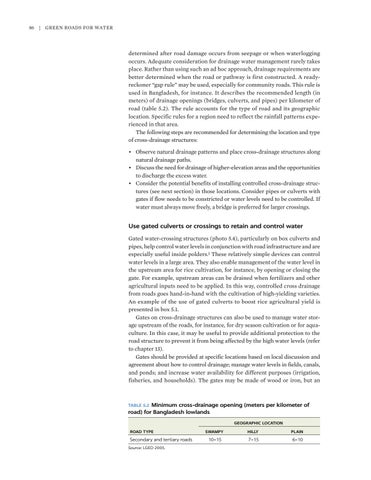86 | Green Roads for Water
determined after road damage occurs from seepage or when waterlogging occurs. Adequate consideration for drainage water management rarely takes place. Rather than using such an ad hoc approach, drainage requirements are better determined when the road or pathway is first constructed. A ready- reckoner “gap rule” may be used, especially for community roads. This rule is used in Bangladesh, for instance. It describes the recommended length (in meters) of drainage openings (bridges, culverts, and pipes) per kilometer of road (table 5.2). The rule accounts for the type of road and its geographic location. Specific rules for a region need to reflect the rainfall patterns experienced in that area. The following steps are recommended for determining the location and type of cross-drainage structures: • Observe natural drainage patterns and place cross-drainage structures along natural drainage paths. • Discuss the need for drainage of higher-elevation areas and the opportunities to discharge the excess water. • Consider the potential benefits of installing controlled cross-drainage structures (see next section) in those locations. Consider pipes or culverts with gates if flow needs to be constricted or water levels need to be controlled. If water must always move freely, a bridge is preferred for larger crossings.
Use gated culverts or crossings to retain and control water Gated water-crossing structures (photo 5.4), particularly on box culverts and pipes, help control water levels in conjunction with road infrastructure and are especially useful inside polders.1 These relatively simple devices can control water levels in a large area. They also enable management of the water level in the upstream area for rice cultivation, for instance, by opening or closing the gate. For example, upstream areas can be drained when fertilizers and other agricultural inputs need to be applied. In this way, controlled cross drainage from roads goes hand-in-hand with the cultivation of high-yielding varieties. An example of the use of gated culverts to boost rice agricultural yield is presented in box 5.1. Gates on cross-drainage structures can also be used to manage water storage upstream of the roads, for instance, for dry season cultivation or for aquaculture. In this case, it may be useful to provide additional protection to the road structure to prevent it from being affected by the high water levels (refer to chapter 13). Gates should be provided at specific locations based on local discussion and agreement about how to control drainage; manage water levels in fields, canals, and ponds; and increase water availability for different purposes (irrigation, fisheries, and households). The gates may be made of wood or iron, but an
TABLE 5.2 Minimum cross-drainage opening (meters per kilometer of road) for Bangladesh lowlands GEOGRAPHIC LOCATION ROAD TYPE
Secondary and tertiary roads Source: LGED 2005.
SWAMPY
HILLY
PLAIN
10–15
7–15
6–10







































